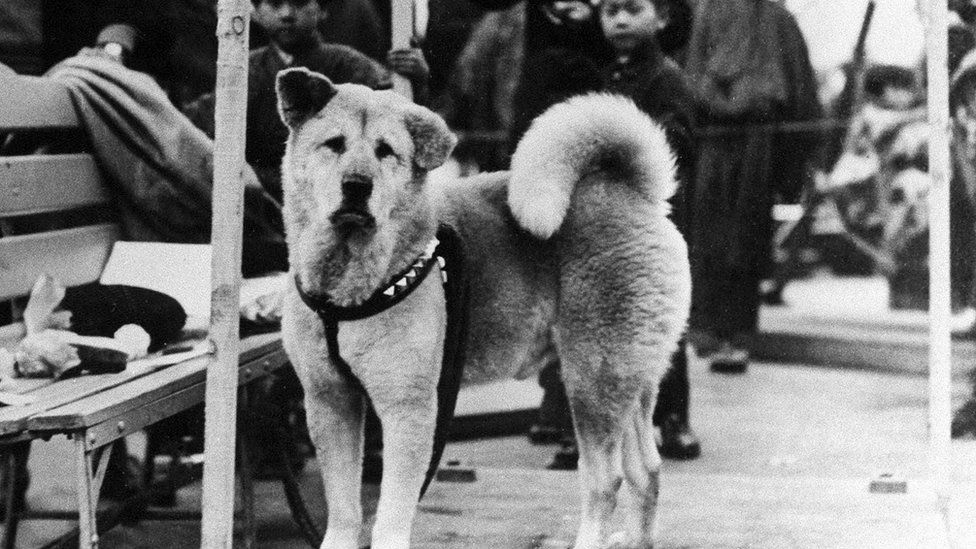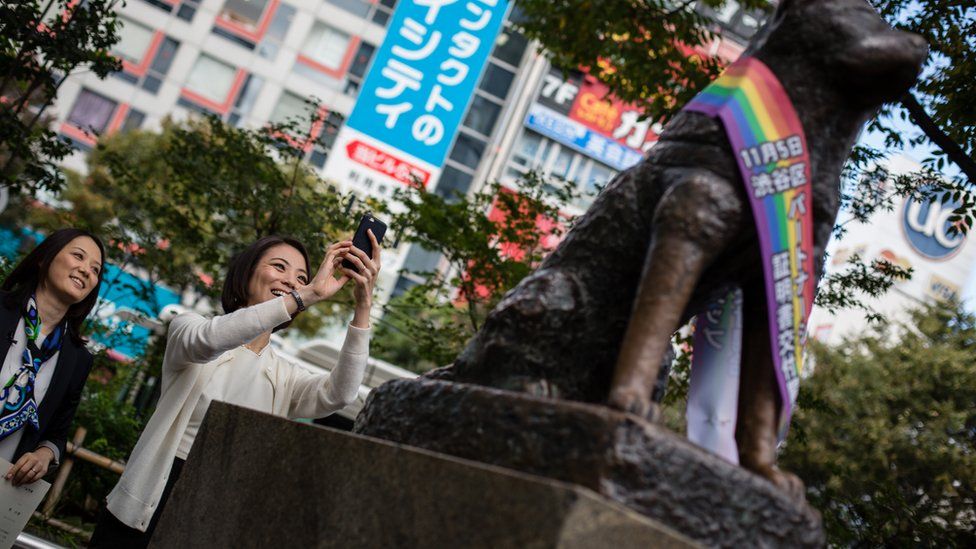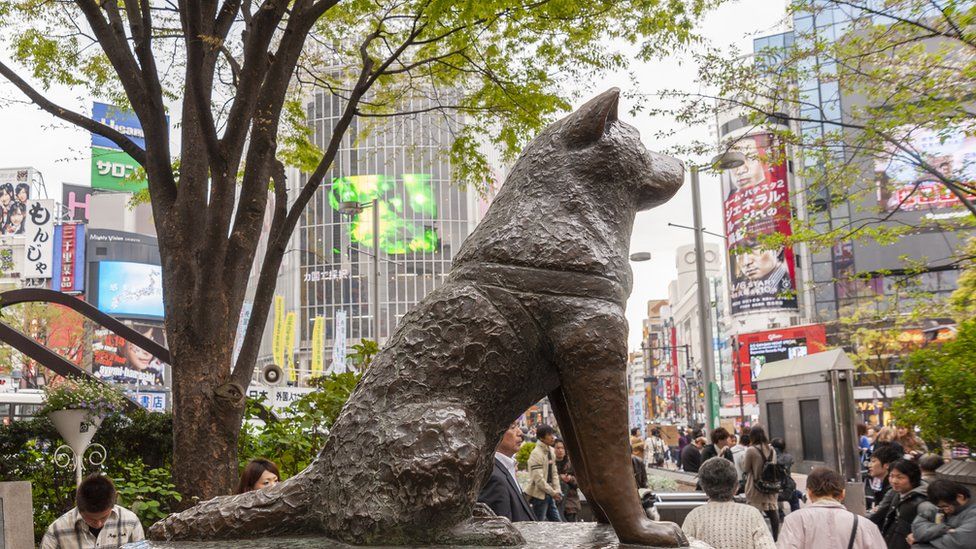The movie's Chinese tagline, which reads, "I will wait for you, no matter how long it takes," says it all. ".
It recounts the true incident of Hachiko, a devoted dog who waited at a Japanese train station for its owner long after he had passed away.
The 100-year-old cream-white Akita Inu has been celebrated in a variety of media, including books, films, and the cult science fiction sitcom Futurama. Additionally, the Chinese adaptation—the third following a 1987 Japanese release and a 2009 film starring Richard Gere—is a box office success.
There are stories of other devoted dogs, like Greyfriars Bobby, but none have the widespread influence of Hachiko.
Since 1948, a bronze statue of him has been erected in front of Shibuya Station in Tokyo, the location of his futile ten-year wait. The statue was initially built in 1934 and later recycled for use in World War Two. As an illustration of loyalty and devotion, Japanese schoolchildren are taught the tale of Chuken Hachiko, also known as the obedient dog Hachiko.
According to Professor Christine Yano of the University of Hawaii, Hachiko represents the "ideal Japanese citizen" with his "unwavering devotion"; he is "loyal, reliable, obedient to a master, understanding, without relying upon rationality, their place in the larger scheme of things.".
In Odate, the original birthplace of Akitas in Akita Prefecture, Hachiko was born in November 1923.
The Akita is one of Japan's oldest and most well-known breeds of large Japanese dogs. They used to be trained to hunt animals like wild boar and elk, and the Japanese government designated them as a national icon in 1931.
According to Eietsu Sakuraba, the author of a children's book in English about Hachiko, "Akita dogs are calm, sincere, intelligent, brave, [and] obedient to their masters.". It also has a stubborn personality and is wary of people other than its master, on the other hand. ".
Hidesaburo Ueno, a well-known agricultural professor who also loved dogs, asked a student to help him find an Akita puppy the year Hachiko was born.

The puppy arrived at the Ueno residence in the Shibuya neighborhood on January 15, 1924, after a torturous train ride, where it was initially believed to be dead. Hachiko was nursed back to health by Ueno and his wife Yae over the course of the following six months, according to Hachiko's biographer, Prof. Mayumi Itoh.
His name is Hachi, which means eight in Japanese. Ko is a title given by the students of Ueno.
Several times per week, Ueno rode the train to work. He brought his three dogs, including Hachiko, to Shibuya station. The three would then remain there as they awaited his evening arrival.
Ueno, 53 at the time, passed away from a cerebral hemorrhage on May 21. Only 16 months had passed since Hachiko had joined him.
Hachi entered the living room after smelling Dr. Ueno while guests were attending the wake. He hid himself under the casket and wouldn't move, according to Prof. Itoh.
Hachiko stayed with various families outside Shibuya for the following few months before finding a home with Ueno's gardener Kobayashi Kikusaburo in the summer of 1925.
Hachiko soon resumed his daily commute to the station, come rain or shine, after returning to the neighborhood where his late master resided. .
According to Prof. Itoh, "Hachi stood on four legs at the ticket gate in the evening and looked at each passenger as if he were looking for someone.". He was initially viewed as a nuisance by station staff. He was doused in water by yakitori vendors, and he was bullied and hit by young boys.
But after a Japanese newspaper, Tokyo Asahi Shimbun, wrote about him in October 1932, he became well-known across the country.
Every day, the station received food donations for Hachiko, and people traveled from all over to see him. About him, haiku and poetry were written. A gathering of 3,000 people is said to have attended a fundraiser in 1934 to create a statue honoring him.
The eventual passing of Hachiko on March 8th, 1935 made many newspapers' front pages. Buddhist monks prayed for him at his funeral, and dignitaries read eulogies. The following days, thousands of people went to see his statue.

An effort to raise money for a new statue of Hachiko in post-war, impoverished Japan even succeeded in raising 800,000 yen, which was a significant amount at the time and is now worth 4 billion yen (£22 million; $28 million).
In hindsight, Okamoto Takeshi stated, "I feel that he knew that Dr. Ueno would not return, but he kept waiting - Hachiko taught us the value of keeping faith in someone," in a newspaper article from 1982. He had observed Hachiko at the station every day while he was a high schooler.
Keeping Hachiko in mind.
A memorial service for Hachiko is held annually on April 8th in front of Shibuya Station. He frequently has scarves, Santa hats, and most recently, a surgical mask on his statue.
The National Museum of Nature and Science in Tokyo has his mount on display. Along with Ueno and Yae, some of his remains are buried at the Aoyama Cemetery. Additionally, statues of him have been erected in Rhode Island, the American setting for the 2009 film, the University of Tokyo, Hisai, Odate, and the hometown of Ueno.
In addition, Odate has a number of celebrations planned for his 100th birthday this year.
Prof Yano predicts that the world's most devoted dog will continue to be honored a century from now because she holds that the "heroism of Hachiko" is timeless and not limited to any one time or place.
Mr. Sakuraba shares the same outlook. "This unwavering, devoted love will still exist in a century from now, and Hachiko's story will endure forever.
. "







